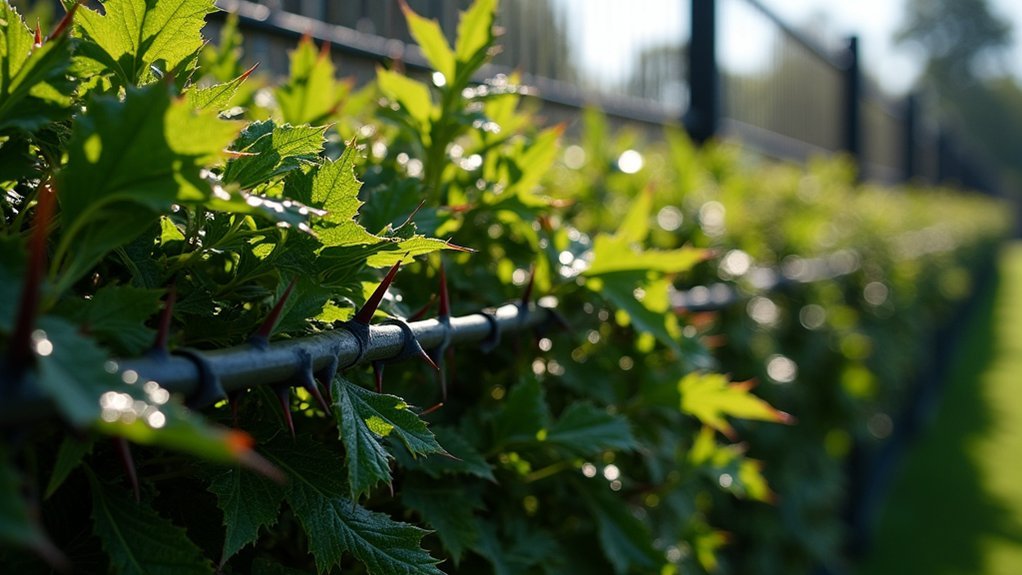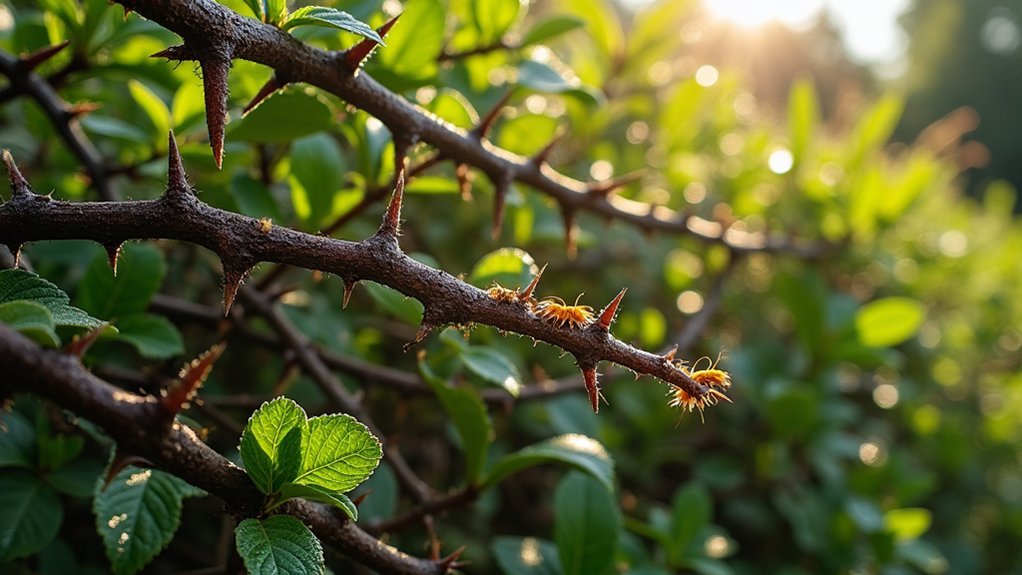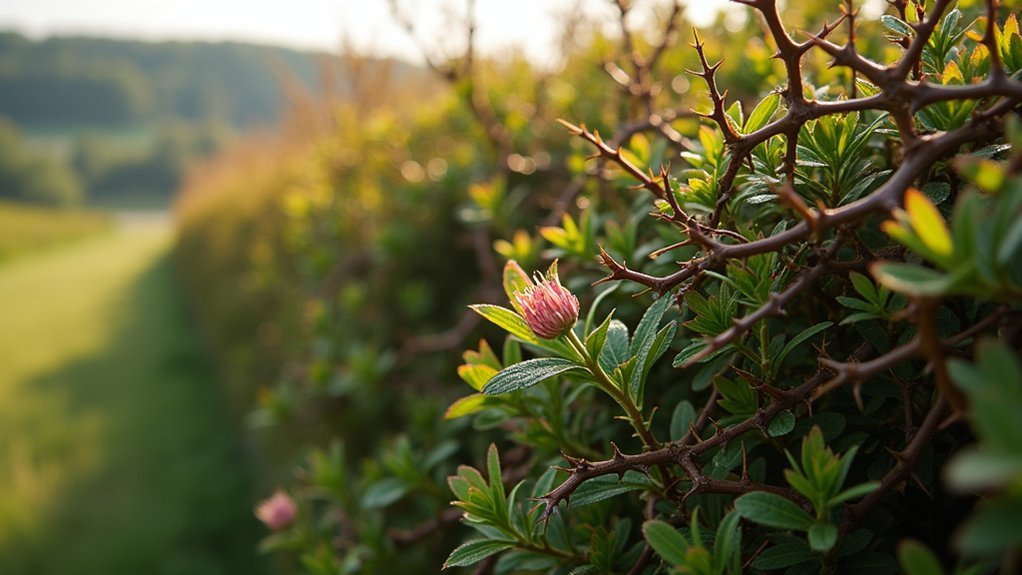Thorny hedges offer superior security over traditional barriers through their natural deterrence, adaptive growth patterns, and noise-generating properties when disturbed. You’ll benefit from their eco-friendly profile, cost-effectiveness, and minimal maintenance requirements while creating wildlife habitats that improve air quality and soil stability. Species like pyracantha, holly, and blackthorn provide year-round protection with attractive features. Discover how these living walls can transform your property’s security while enhancing its ecological value and curb appeal.
Security Benefits of Thorny Hedges vs. Traditional Barriers

While traditional fencing and walls have long dominated the security barrier market, thorny hedges offer compelling biological deterrents that often outperform their manufactured counterparts. Their piercing thorns and dense growth create a more psychologically intimidating barrier than flat surfaces, imposing immediate physical risk to would-be intruders.
You’ll benefit from the adaptive growth patterns that naturally fill gaps over time, unlike rigid fences that remain vulnerable to breaches. These living barriers generate noise when disturbed, alerting you to potential intrusion attempts. The eco-friendly nature of thorny hedges provides a cost-effective security solution that requires minimal maintenance compared to conventional barriers.
The non-standardized arrangement of branches and thorns also complicates trespassers’ strategies, while reducing visibility of your valuables compared to open fencing. For year-round protection, evergreen species like pyracantha maintain their defensive capabilities even in winter when deciduous options might falter.
Top Thorny Species for Creating Natural Defensive Perimeters
You’ll find several dense evergreen options like holly and blackthorn that offer year-round security while maintaining their protective foliage throughout the seasons.
For added visual interest, consider colorful berry producers such as Pyracantha (Firethorn) that combine security with vibrant red, orange, or yellow berries during autumn and winter.
These eye-catching species not only create effective defensive perimeters but also attract birds and wildlife, enhancing your garden’s biodiversity while maintaining its protective function. Strategic placement of these plants in vulnerable corners enhances security while complementing your overall landscape design.
Dense Evergreen Options
Security enthusiasts seeking year-round protection will find dense evergreen species particularly valuable for defensive perimeters. Pyracantha, commonly called Firethorn, delivers the perfect combination of sharp thorns and evergreen foliage that forms an effective natural barrier.
If you’re looking for classic security with aesthetic appeal, consider Holly with its distinctive spiny leaves that maintain their defensive properties throughout the seasons.
Blackthorn works exceptionally well for field borders and windswept locations, while Mahonia trifoliolata (Agarita) presents an excellent option with its extremely prickly leaves for suitable climates.
Don’t overlook Berberis varieties, which add vibrant color while creating formidable barriers with their spiny stems. These hardy plants provide an eco-friendly alternative to traditional security solutions while maintaining their protective capabilities.
These evergreen options guarantee your security hedge remains effective regardless of season, providing continuous protection without compromising on visual appeal.
Colorful Berry Producers
Beyond their defensive capabilities, many thorny species offer the added benefit of vibrant berries that transform protective barriers into visual showcases throughout the year.
Pyracantha stands out with its spectacular clusters of red, orange, or yellow berries that persist from fall into spring, attracting birds while maintaining its impenetrable thorny structure.
Holly combines sharp-spined glossy leaves with iconic red winter berries, creating year-round privacy and wildlife habitat.
For more rustic settings, Blackthorn delivers blue-black sloes in autumn, perfect for traditional preserves while forming dense defensive thickets.
Berberis offers compact protection with varied foliage colors and red autumn berries, ideal for window borders. With Berberis plants starting from just £5.99 per plant, they represent an affordable option for enhancing security.
If you have space, consider White-Stemmed Bramble for its striking contrast between ghostly white stems, purple thorns, and eventual fruit.
Environmental Advantages of Living Security Boundaries

While traditional security fences offer protection, thorny hedges deliver powerful environmental benefits that extend far beyond their defensive capabilities.
Their dense foliage captures airborne pollutants and reduces particulate matter, improving air quality around your property.
You’ll support local wildlife by providing essential nesting sites and food sources through berries and nectar. Thorny hedges create unique plant communities due to their structural density, adding ecological complexity to urban landscapes.
Thorny hedges also excel at carbon sequestration, storing it in their woody biomass and enhancing soil carbon retention.
Thorny hedges trap carbon from our atmosphere, locking it away in both plant material and enriched soil beneath.
When rain falls, your living boundary slows water runoff, prevents erosion, and improves groundwater recharge – vital for flood prevention.
You’ll appreciate their thermal benefits too; hedges act as windbreaks that reduce energy costs while absorbing noise pollution.
Unlike manufactured alternatives, these natural barriers continuously improve your local environment while maintaining security.
Designing Your Property’s Thorny Defense System
Your thorny defense system’s success depends on strategic placement around vulnerable entry points and along property perimeters.
Choose plant species based on your climate zone, growth rate needs, and maintenance capacity, balancing evergreen varieties with seasonal bloomers for year-round protection.
Regular pruning, proper spacing, and integrated pest management will keep your living barrier both beautiful and functional without creating an overgrown security risk. Consider incorporating bougainvillea along trellises for a perimeter that provides both vibrant colored petals and concealed thorns for security.
Strategic Placement Principles
Creating an effective security barrier with thorny plants requires strategic thinking about placement throughout your property. Position thorny shrubs beneath ground-floor windows to make unauthorized entry painful and difficult. For thorough protection, establish thorny climbers along fences and walls to prevent scaling, while using dense hedges to secure property boundaries.
- Place prickly plants near gates and entry points where intruders might first attempt access.
- Create layered defenses with taller thorny shrubs at the back and smaller varieties in front.
- Focus on vulnerable corners and blind spots where traditional security measures might be lacking.
Remember to maintain proper sightlines for surveillance while ensuring your defensive plants don’t create hiding spots that could compromise security. Incorporating gravel or pebbles around your thorny plants creates an audible warning system when stepped on by potential intruders. Regular pruning keeps your thorny barrier both effective and aesthetically pleasing.
Species Selection Guide
Selecting the right thorny plants forms the foundation of an effective defensive barrier around your property. Consider Pyracantha (firethorn) for its sharp thorns and colorful berries, or Hawthorn for exceptional density, particularly popular in UK landscapes.
Blackthorn offers seasonal appeal with spring blossoms while maintaining robust protection. For varying growth habits, explore different Berberis species, or choose Gorse when you need an impenetrable thicket.
Your selection should align with local climate conditions to guarantee long-term resilience and reduced maintenance. When planning your thorny hedge, verify compliance with local regulations. Berberis darwinii is an excellent option for properties with heavy clay soil that still need protective barriers.
Remember that the most effective defensive hedges combine security with aesthetic appeal—your thorny barrier can simultaneously protect your property and enhance its visual charm while supporting local wildlife.
Maintenance Planning Tips
While establishing a thorny hedge provides immediate security benefits, proper maintenance determines its long-term effectiveness as a protective barrier.
Plan your pruning schedule for late winter when plants are dormant to minimize stress and promote vigorous spring growth. For established hedges, implement a three-year rejuvenation method, removing one-third of the oldest stems each year to maintain density without compromising protection. Always wear proper safety equipment when working with thorny hedges to prevent injuries to hands, arms, and eyes.
Shape your hedge with a tapered profile—narrower at the top—to prevent lower branches from dying off due to lack of sunlight, which could create security gaps.
- Remove the thickest stems first to stimulate new growth at the base
- Document your trimming history to predict growth patterns and plan future interventions
- Avoid pruning during nesting seasons to comply with wildlife protection regulations
Seasonal Considerations for Thorny Hedge Maintenance
Effective maintenance of thorny hedges hinges on understanding the natural growth cycles that influence their protective qualities throughout the year. You’ll achieve ideal security by timing your pruning activities to match seasonal needs.
During dormancy, focus on structural pruning to direct energy toward dense growth when spring arrives. As active growth begins, switch to light trimmings that encourage bushiness without creating vulnerable gaps in your barrier. When maintaining thorny hedges, always check for nesting birds before beginning any pruning work, as they are protected under the Wildlife & Countryside Act 1981.
| Season | Key Activities | Benefits |
|---|---|---|
| Winter | Heavy pruning, disease inspection | Shapes structure, removes weakness |
| Spring | Light trimming, fertilization | Stimulates thorn production |
| Summer | Targeted pruning, pest monitoring | Maintains density, protects new growth |
| Fall | Minimal cutting, cleanup | Preserves buds, prevents disease |
Remember to align maintenance with flowering schedules—spring bloomers need post-flower pruning while summer varieties benefit from late winter attention.
Wildlife-Friendly Security: The Ecological Role of Defensive Hedging

Thorny hedges serve a dual purpose beyond simply securing your property—they create vibrant ecosystems that benefit local wildlife while maintaining robust protective barriers.
These living fences provide essential habitats for birds, small mammals, and beneficial insects that contribute to your garden’s health through natural pest control. The strategic planting of these hedges can create wildlife corridors that promote ecological connectivity throughout the landscape.
Living barriers that shelter wildlife while offering free garden protection services through nature’s own defense system.
When you plant flowering varieties like pyracantha or native hawthorn, you’ll support pollinators while deterring unwanted human visitors. These hedges produce berries and fruits that feed wildlife throughout harsh winter months when food sources are scarce.
- Dense, thorny structures offer nesting sites protected from predators for ground-nesting birds
- Berry-producing plants attract diverse species while creating movement corridors between fragmented habitats
- Root systems stabilize soil, reduce erosion, and sequester carbon, enhancing your property’s environmental resilience
Cost Analysis: Thorny Hedges as Long-Term Security Investments
Beyond their ecological value, thorny hedges stand out as surprisingly cost-effective security solutions when compared to traditional barriers. At just 4% the cost of concrete walls, they offer dramatic upfront savings while providing decades of protection without significant depreciation.
| Cost Factor | Thorny Hedges | Traditional Barriers |
|---|---|---|
| Installation | ~$200 per linear foot | $2,000+ per linear foot |
| Lifespan | Decades with proper care | Requires replacement/repair |
| Maintenance | Semi-annual pruning | Painting, rust removal, repairs |
You’ll find additional financial benefits through reduced permitting hurdles and possible insurance incentives. By implementing staggered planting of native species and establishing documented maintenance plans, you’ll control long-term costs while creating an effective deterrent that enhances your property’s value rather than deteriorating over time. Our expert consulting services include site visits that analyze and recommend the optimal placement of thorny hedges for maximum security effectiveness.
Aesthetic Integration of Protective Plants in Landscape Design

When integrating protective plants into your landscape design, you’re actually merging security with visual appeal rather than sacrificing one for the other.
Consider the year-round interest that thorny plants like berberis and hawthorn provide—spring blooms, summer foliage, autumn berries, and winter structure.
You can create visual depth by combining low-growing thorns like Rosa rugosa with taller species such as Crataegus, establishing tiered barriers that enhance your landscape’s perceived depth.
For striking focal points, incorporate silver-leaved thorny bushes or red-stemmed brambles against darker foliage. These thorny shrubs not only create beautiful contrasts but also provide habitat for various wildlife species and support biodiversity in garden ecosystems.
- Use curvilinear patterns to soften hardscapes or straight-line plantings to emphasize boundaries
- Frame entryways with symmetrical thorny specimens for structured arrivals
- Position lower-growing thorny plants beneath windows to maintain upward views while securing ground level
Growth Patterns and Training Techniques for Maximum Protection
Understanding the growth patterns of thorny hedges forms the foundation of effective protective barriers that deter unwanted visitors while enhancing your landscape. Different species grow at varying rates, requiring tailored maintenance schedules to achieve ideal density.
Thorny hedges provide natural security through strategic growth management, combining protection with aesthetic appeal
You’ll need regular pruning to direct growth and eliminate potential weak points. Support young hedges structurally to guarantee uniform development, and conduct year-round inspections to maintain an impenetrable barrier.
Quality soil promotes robust root systems, creating stronger, more resilient hedges. Species selection matters considerably—consider Pyracantha for its formidable thorns and vibrant berries, or Blackthorn for exposed locations. Many thorny plants have evolved as survival mechanisms against herbivores, making them naturally effective as protective barriers.
Once established, your thorny hedge becomes more cost-effective than traditional fencing while providing additional environmental benefits like wildlife habitat and soil erosion prevention. With proper training, you’ll create a sustainable, long-lasting security solution.
Frequently Asked Questions
Are Thorny Hedges Legal in Residential Neighborhoods?
Thorny hedges are generally legal in residential neighborhoods, but you’ll need to check your local regulations, as height restrictions, maintenance requirements, and neighborhood covenants may apply. Permits might be needed for certain types.
How Quickly Can Thorny Hedges Establish Effective Security?
You’ll see initial deterrence within 6-12 months, but thorny hedges need 3-5 years to form truly impenetrable barriers. Strategic planting and larger nursery stock accelerate security benefits during the establishment phase.
Can Thorny Hedges Damage House Foundations or Underground Utilities?
Yes, they can damage your home. Plant thorny hedges at least 3-5 feet from foundations to prevent their aggressive roots from exploiting cracks. They’ll also seek water from utilities, potentially infiltrating pipes.
How Do Emergency Services Navigate Properties With Thorny Perimeters?
Emergency services navigate thorny perimeters using pre-planning, specialized equipment, and alternative access points. They’re trained to handle such obstacles, though you’ll help them by maintaining clear emergency access paths on your property.
Are Thorny Hedges Dangerous for Households With Young Children?
Yes, thorny hedges pose risks to young children. They can cause cuts, punctures, and skin irritation. You’ll need to supervise closely, maintain hedges regularly, and consider safer alternatives for your family’s outdoor space.
In Summary
By choosing thorny hedges as protective barriers, you’re gaining multi-layered benefits that extend far beyond security. You’ll create a natural deterrent that’s visually appealing, environmentally sound, and wildlife-supporting while adding property value. With proper species selection and maintenance, your living security system will grow stronger each year, providing an elegant solution that’s both effective and sustainable—a truly wise investment for your home’s protection.





Leave a Reply